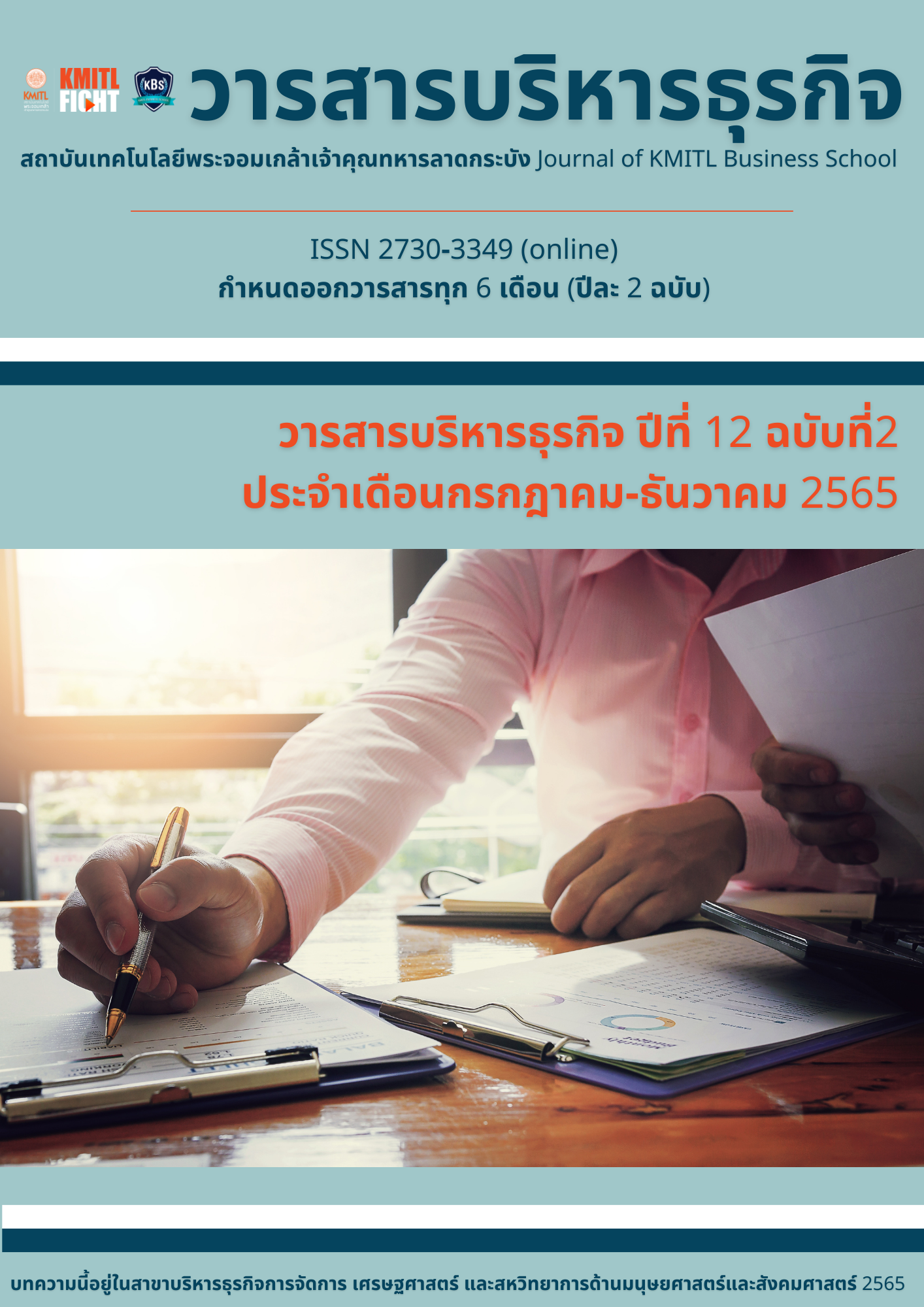ELECTRONIC WORD OF MOUTH AND CUSTOMERS’ PURCHASE INTENTION OF SAMSUNG FOLDABLE SMARTPHONE
Main Article Content
Abstract
This research aimed to examine the impacts of electronic word-of-mouth (eWOM) and customers’ purchase intention of Samsung foldable smartphones. This research sample consisted of 200 consumers interested in Samsung foldable smartphones and who had watched information or reviews about Samsung foldable smartphones in electronic videos such as YouTube, TikTok, Facebook, or other social media. The statistics for data analysis included percentage, mean, and standard deviation. The hypothesis was tested by Structural equation modeling (SEM) with AMOS. The opinions of electronic word-of-mouth on the Information usefulness of the eWOM at an excellent level, Information Quality, Information credibility, Needs of information, and Information acceptance of the eWOM at a good level. The structural equation model of electronic word-of-mouth had the goodness-of-fit indices, showing that the model fitted the data quite well: χ2 = 131.490, d.f. = 130, χ2/ d.f. = 1.011, p-value = 0.447, GFI = 0.944, AGFI = 0.901, NFI = 0.952, CFI = 0.999, RMR = 0.075, and RMSEA = 0.008. The results of the hypothesis testing were as follows: Information Quality, Information credibility, Needs of information, Information usefulness of the eWOM, and Information acceptance of the eWOM influencing customers’ purchase intention of Samsung foldable smartphones with a statistical significance of 0.05 and could be explained by 16.9 %.
Article Details

This work is licensed under a Creative Commons Attribution-NonCommercial-NoDerivatives 4.0 International License.
Journal of KMITL Business School is available both online and in printed version.
**All articles or opinions presented in this issue of the Journal of KMITL Business School reflect the thoughts of their respective authors. This journal serves as an independent platform for a variety of viewpoints. Authors bear full responsibility for the content of their articles.**
**All articles published in this journal are copyrighted by KMITL Business School, King Mongkut's Institute of Technology Ladkrabang. The editorial team permits copying or using articles, but a reference to the journal is required.**
References
An, D., Ji, S., & Jan, I. (2021, 01 14). Investigating the Determinants and Barriers of Purchase Intention of Innovative New Products. Sustainability(13), p. 740. doi:10.3390/su13020740.
Terry, B. (2019). Beginning of the new smartphone era. Marriott Student Review(1), 10.
TNN, ช. (2022, Mar 7). Samsung ตีแตก !! ครองตลาดมือถือจอพับเป็นเจ้าแรกของโลก. Retrieved Mar 15, 2022, from news.trueid.net: https://news.trueid.net/detail/KVGjPbQQ719a.
Fayossy, a. (2015, July 29). ความสำคัญของ Customer Review ต่อการตัดสินใจซื้อ. Retrieved from marketingoops: https://www.marketingoops.com/reports/infographic-reports/impact-online-reviews-customers-buying-decisions/.
Fayossy, b. (2015, Jan 29). [Case Study] 10 วิธีการทำ Viral Video ให้ประสบความสำเร็จ. Retrieved from marketingoops: https://www.marketingoops.com/exclusive/case-studies-exclusive/case-study-10-how-to-viral-video-marketing/.
Hair, J., Black, W., Babin, B., & Anderson, R. (2010). Multivariate Data Analysis (Vol. 7th Edition). New York: Pearson.
มนตรี พิริยะกุล. (2021). การกำหนดขนาดตัวอย่างสำหรับการวิเคราะห์ตัวแบบสมการโครงสร้าง. วารสารวิชาการเทคโนโลยีอุตสาหกรรม, 17(3), 232-246. doi:10.14416/j.ind.tech.2021.12.007
ตัรมีซี สาและ. (2562). ศึกษาแนวทางการจัดตั้งองค์กรบริหารจัดการซะกาต กรณีศึกษา จังหวัดนราธิวาส. การประชุมวิชาการระดับชาติมหาวิทยาลัยทักษิณ ครั้งที่ 29 (pp. 695-709). หาดใหญ่: สถาบันวิจัยและพัฒนา มหาวิทยาลัยทักษิณ วิทยาเขตพัทลุง.
Schumacher, R., & Lomax, R. (2010). A Beginners Guide to Structural Equation Modelling. New Jersey: Lawrence Erlbaum Associates.
Hair, J., Black, W., Babin, B., Anderson, R., & Tatham, R. (2006). Multivariate Data Analysis (6th ed.). Upper Saddle River, NJ: Pearson Prentice Hall.
Diamantopoulos, A., & Siguaw, J. A. (2000). Introducing LISREL: A Guide for the Uninitiated . London: SAGE Publications, Inc.
Olshavsky, R. (1985). Perceived quality in consumer decision making: an integrated theoretical perspective. Perceived Quality: How Consumers View Stores and Merchandise, 3-29.
กชกร พินิจรัตนารักษ์. (2562). อิทธิพลของการสื่อสารแบบปากต่อปากบนอินเทอร์เน็ตต่อทัศนคติต่อตราสินค้า การรับรู้คุณค่าของการบริโภค และการตัดสินใจซื้อโทรศัพท์เคลื่อนที่สมาร์ทโฟน. วารสารระบบสารสนเทศด้านธุรกิจ (JISB), 78-99.
Purcarea, V., Gheorghe, I. R., & Petrescu, C. (2013). Credibility Elements of eWOM Messages in the Context of Health Care Services. A Romanian Perspective. Journal of medicine and life, 254-9.
Nardali, S., Rahman, M., Dogan, S., & Erkan, I. (2019). Text me on WhatsApp, let us talk about brands! The power of mobile word of mouth on mobile purchase intention. International Journal of Internet Marketing and Advertising, 218.
Leong, C., Loi, A., & Woon, S. (2022). The influence of social media eWOM information on purchase intention. Journal of Marketing Analytics, 1-13.
Hoffman, D., & Novak, T. (1997). Marketing in Hypermedia Computer-Mediated Environments: Conceptual Foundations. Journal of Marketing, 50-68.
Yaseen, S., & Jusoh, N. M. (2021). THE INFLUENCE OF ELECTRONIC WORD OF MOUTH IN SOCIAL MEDIA ON CONSUMERS' PURCHASING INTENTIONS IN JORDAN. lköretim Online, 850-857.
Sardar, A., Manzoor, A., Shaikh, K., & Ali, L. (2021). An Empirical Examination of the Impact of eWom Information on Young Consumers’ Online Purchase Intention: Mediating Role of eWom Information Adoption. SAGE Open, 215824402110525.
Cheung, C. M., & Thadani, D. (2012). The impact of electronic word-of-mouth communication: A literature analysis and integrative model. Decision Support Systems, 461-470.
Erkan, I., & Evans, C. (2016). The influence of eWOM in social media on consumers’ purchase intentions: An extended approach to information adoption. Computers in Human Behavior, 47-55.


